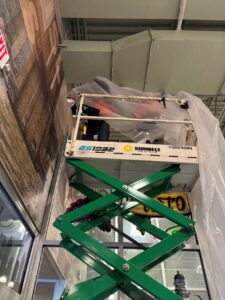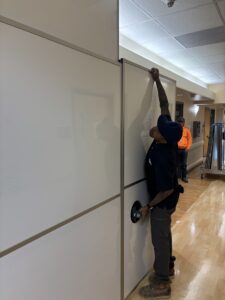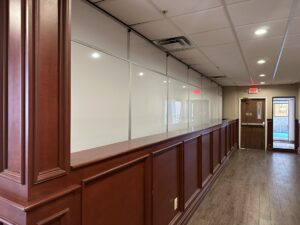Managing Commercial Construction for Occupied Facilities
Maintenance, expansion, or technology-driven upgrades are essential for the upkeep of commercial facilities, leading to periodic construction projects. Yet, managing commercial construction for occupied facilities can be quite challenging, given the weeks or months these projects may take, plus other challenges.
In this article, we’ll first tackle the significance of commercial construction for businesses and demonstrate how they are applied through different industries such as offices, malls, airports, retail, schools, hospitals, etc. Before starting a construction project for commercial purposes, we’ll discuss various factors and help you prepare. And lastly, we’ll guide you through how to manage commercial construction for occupied facilities.
Factors to Consider Before a Commercial Construction Project
Before initiating a commercial construction project for occupied facilities, here are some considerations that can significantly impact the project’s outcome below:
Location
The location of the occupied commercial structure plays a significant role in the growth of the business. It is important to keep the business running smoothly, especially for loyal customers who are familiar with the business’s location. Being considerate of the entries and exits of the location will keep customers comfortable with visiting the location.
Budget
Ensuring the success of any commercial project for occupied facilities begins with careful financial planning. Before you start, set a budget that covers all potential costs, from materials to permits, labor, contractor fees, contingencies, and other associated expenses. Enlist the assistance of a professional contractor to provide a reliable cost estimate
Project Timeline
Work closely with your general contractor to create a well-structured timeline that covers the entire duration of your commercial project for occupied facilities. It is crucial to have a well-defined schedule to avoid costly delays and keep your construction team focused. It’s a good idea to allow for flexibility in timelines for commercial construction projects, as they often extend beyond their original plans. When planning a project, factors such as permitting processes, weather conditions, material deliveries, labor shortages, and unexpected issues should be taken into consideration
Smartsheet has a great template that can be used for any project. Use this template to help keep everything on track across the whole renovation.
How to Manage Commercial Construction for Occupied Facilities
Renovating a commercial space that is still in use poses unique challenges compared to working in an unoccupied area. Noise, dust, altered access routes, and safety concerns can impact the building’s occupants and visitors. Managing these occupied commercial facilities while constructions takes place requires proactive strategies and careful coordination to ensure a smooth process. Learn more on how to renovate a retail space without closing.
In instances such as healthcare facilities, hospitals, malls, or multi-tenant buildings, shutting down completely is not feasible. Offices and retail spaces need to remain accessible for tenants to continue their operations.
If you’re operating a restaurant and looking for ways to ensure you can keep business going while under renovations, check out our restuarant remodeling checklist.
Here are helpful tips for managing operations and keeping business as usual while construction is ongoing below:
Effective Communication
A key strategy for minimizing construction impacts is ensuring effective communication with tenants and customers. Before construction begins, you should let them know about the upcoming work, providing details on the project timeline, the scope of work, and potential disruptions. This information can be shared through various means, including email, signs, and in-person meetings. Keeping tenants and customers well-informed allows them to plan their schedules accordingly and make any necessary adjustments.
Prioritizing Safety
During construction, it’s vital to ensure the work area stays clean and safe. This could involve using barriers to contain dust and debris, utilizing specialized equipment to control noise, and regularly cleaning the workspace to minimize any impact on tenants and customers. You can contact your specialized contractor for temporary wall systems to help you out with the requirements.
Streamlining Site Traffic and Operations
Parking lots, access roads, and shipping/receiving areas are all key components that can greatly impact both internal operations and external traffic flow.
During the construction phase, factors such as field office setup, material staging, and team parking need to be carefully considered. You need to collaborate with your construction team early in the project to analyze spaces often used, potential sacrifices, and establish a well-thought-out site logistics plan.
Maximize Downtime and Off-hours for Construction
Choosing to remain open during retail renovation may lead to downtime. This is an opportunity to let employees do other tasks such as optimizing staff schedules, creating task lists for quiet periods, and addressing administrative duties like website updates or employee evaluations during unexpected downtime. During the off-hours, contractors may opt to work during these times to reduce disruptions and maintain operational areas.
Work with the Right Team
Managing a construction project within an operational commercial facility may seem challenging, but partnering with a contractor experienced in similar projects can simplify the process.
Conclusion
Commercial construction shapes the business environment by providing the necessary physical infrastructure for the growth and expansion of businesses. From offices to medical facilities, commercial construction projects are vast and have a significant impact on the industry.
Prior to starting a commercial construction project, it is important to pay attention to factors such as suitable location, budgeting, project timelines, compliance with regulations, and selecting an experienced commercial contractor. Successfully managing commercial construction for occupied facilities requires proactive planning, transparent communication, and adaptable strategies to ensure minimal disruption to help the commercial industry maintain business as usual.


